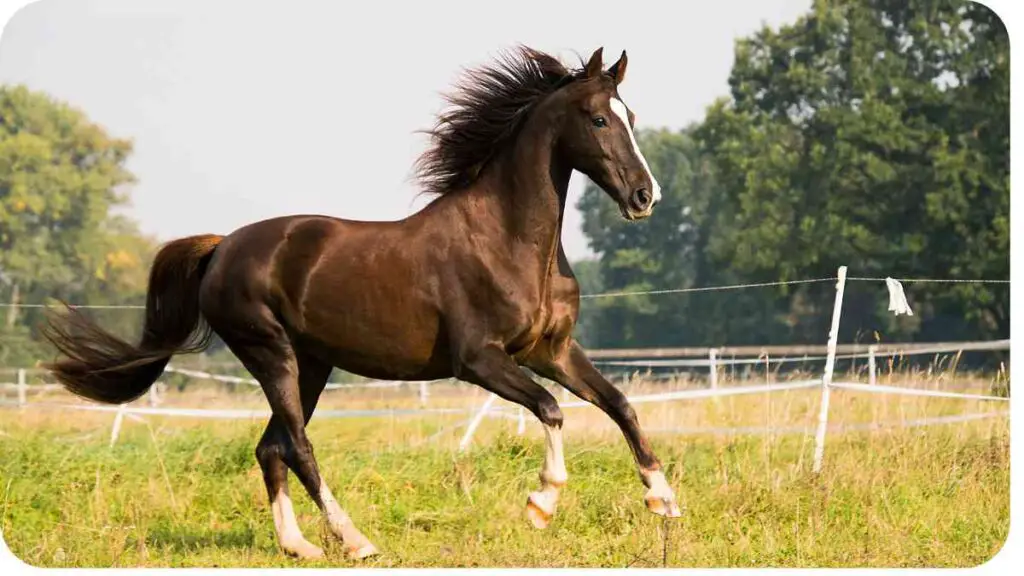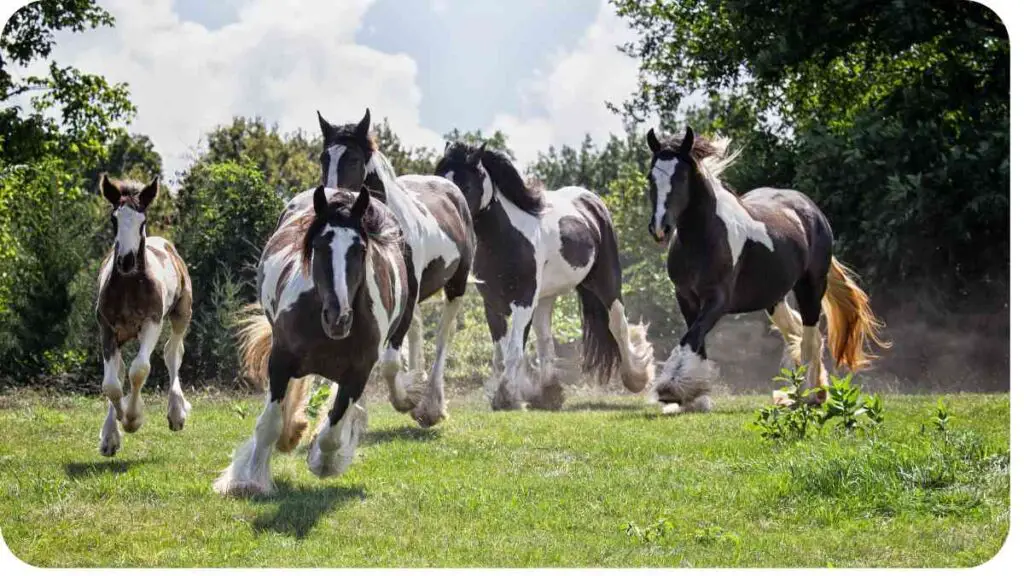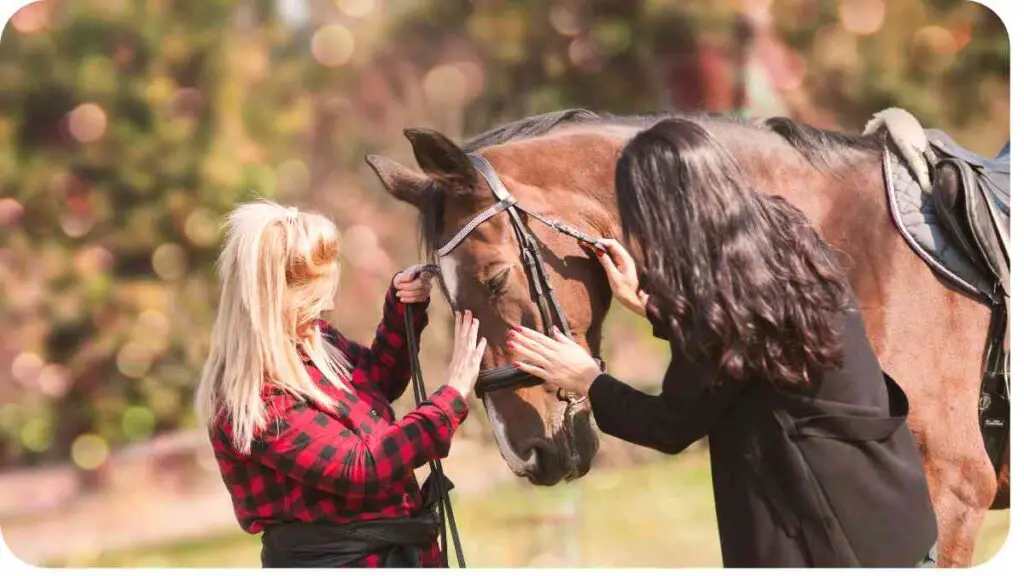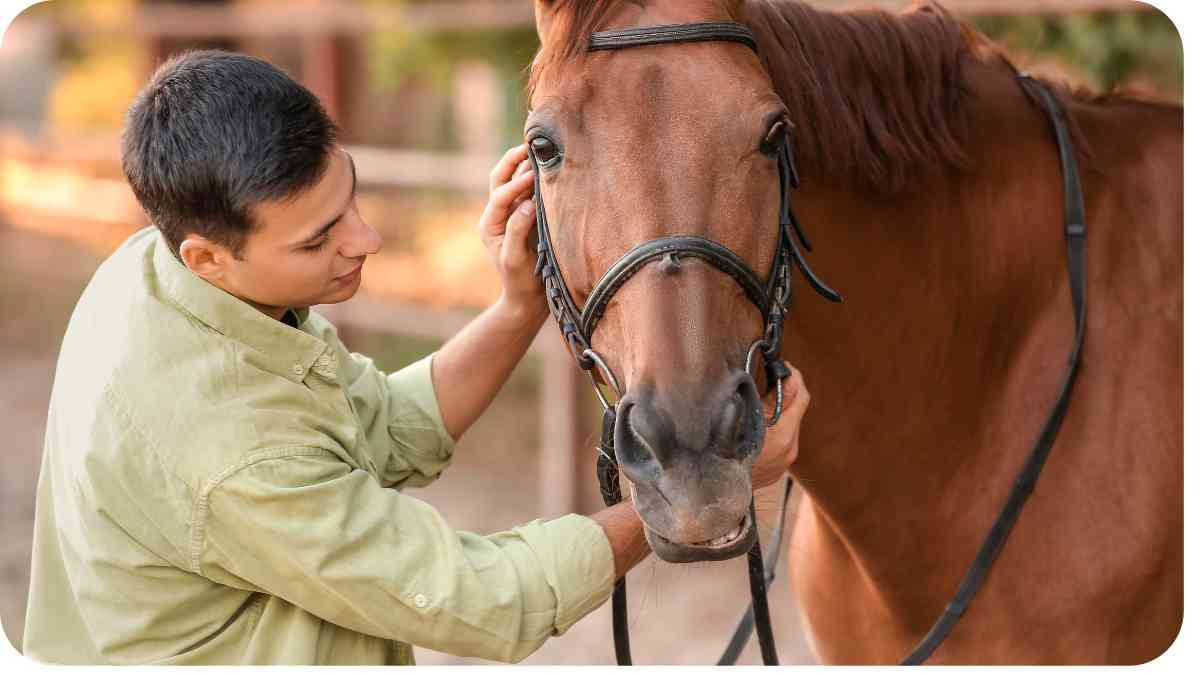Horses, with their majestic presence and complex behaviors, have long fascinated humans. Understanding their behavior is not just about decoding their actions but delving into their psyche to comprehend what drives them.
In this article, we’ll embark on a journey to unravel the science of horse behavior, exploring the intricacies of their psychology, communication patterns, and social dynamics.
| Takeaways |
|---|
| Understanding the science of horse behavior is essential for effective communication and training. |
| All horse behavior is driven by emotions and perceptions, making it crucial to address the root causes of unwanted behaviors. |
| Equine communication involves a combination of body language, vocalizations, and sensory awareness, requiring handlers to be attentive and responsive. |
| Building trust, using positive reinforcement, and maintaining consistency are key strategies for fostering strong bonds and achieving success in horse training. |
| Continued learning and observation are essential for deepening understanding and strengthening relationships with horses. |
2. Insights into Horse Psychology

Horses, as prey animals, have evolved with finely tuned survival instincts. Their flight response is deeply ingrained, making them vigilant and sensitive to their surroundings. Let’s delve into the foundational aspects of equine psychology to gain a deeper understanding of their behavior.
| Behavior Trait | Description |
|---|---|
| Flight Response | Primary survival mechanism; crucial for escaping predators |
| Perceptiveness | Highly attuned to detect threats; reacts to subtle stimuli |
| Fast Response Time | Instant reactions to perceived danger; survival imperative |
| Desensitization | Ability to differentiate harmful vs. harmless stimuli; adaptation |
Understanding these fundamental traits provides a solid foundation for interpreting and addressing horse behavior effectively.
3. Understanding Horse Communication
Communication lies at the heart of every interaction, and horses are no exception. They utilize a rich repertoire of signals to convey their thoughts, feelings, and intentions. Let’s explore the nuances of equine communication and decipher the messages they convey.
Deciphering horse feed labels can be daunting, but understanding them is crucial for your horse’s health. Ensure you’re making informed choices by learning to decode horse feed labels.
| Communication Method | Description |
|---|---|
| Body Language | Silent yet expressive; ears, eyes, head, and tail movements |
| Vocalizations | Nickers, whinnies, and snorts; varying tones and frequencies |
| Herd Dynamics | Hierarchical structure; dominance, submission, and social interactions |
By tuning into their communication cues, we can forge deeper connections with our equine companions and foster mutual understanding.
4. What Your Horse is Trying to Tell You
A horse’s body language is a window into its mind, offering valuable insights into its mood and intentions. By learning to interpret subtle cues, we can better respond to their needs and build trust. Let’s decode the language of equine body signals.
| Body Signal | Interpretation |
|---|---|
| Ears | Forward: Interest; Pinned back: Discomfort or aggression |
| Eyes | Wide, white-eyed: Fear; Relaxed: Calmness |
| Head and Neck | Raised: Curiosity or anxiety; Lowered: Relaxation |
| Tail | Swishing: Irritation or excitement |
Mastering the art of reading body language enhances our ability to communicate effectively with horses.
5. The Sounds of Equine Communication
Horses utilize vocalizations to convey a range of emotions and messages. Each sound carries its own significance, offering valuable insights into their state of mind. Let’s explore the vocal expressions of equine communication.
Recognizing dehydration signs in horses is vital for their well-being. Learn how to spot them early and implement effective solutions to keep your horse hydrated with this guide on horse dehydration.
| Vocalization | Meaning |
|---|---|
| Nickers | Affection or greeting; soft and welcoming |
| Whinnies | Call for attention or companionship; high-pitched and drawn-out |
| Snorts | Sign of alarm or clearing the air; varying tones and intensity |
Understanding the language of equine vocalizations enriches our communication with horses and strengthens our bond.
6. The Pecking Order in Horse Herds

Within a horse herd, a complex social hierarchy dictates interactions and relationships. Understanding this hierarchy sheds light on the dynamics of equine society and informs our interactions with them. Let’s delve into the intricacies of herd dynamics and the roles horses play within their social structure.
| Social Structure | Description |
|---|---|
| Alpha Leader | Dominant horse; establishes authority and sets the tone for the herd |
| Lieutenants | Supportive individuals; maintain order and assist the alpha leader |
| Subordinate Members | Rest of the herd; varying degrees of social standing and influence |
Recognizing the dynamics of the equine social ladder allows us to navigate interactions with horses effectively and respectfully.
7. Strategies for Effective Leadership
In the realm of horse training and handling, establishing dominance is crucial for effective communication and leadership.
However, dominance is not about exerting control through force but rather earning respect and trust through clear and consistent guidance. Let’s explore strategies for establishing dominance in a manner that fosters mutual respect and understanding.
| Dominance Techniques | Approach |
|---|---|
| Clear Communication | Consistent cues and boundaries; clarity in expectations |
| Positive Reinforcement | Rewarding desired behaviors; reinforcing trust and cooperation |
| Assertive Body Language | Confident posture and movements; conveying leadership |
By employing these techniques, we can cultivate a harmonious relationship with our horses built on mutual trust and respect.
8. Building Trust and Communication
Education and training play pivotal roles in shaping a horse’s behavior and responsiveness to cues. Through patient and empathetic methods, we can nurture trust, confidence, and communication with our equine partners. Let’s explore approaches to education and training that prioritize the horse’s well-being and cooperation.
Addressing common horse behavior problems requires insight and patience. Equip yourself with valuable tips and tricks to troubleshoot and manage these issues effectively by exploring this guide on horse behavior problems.
| Training Principles | Methodology |
|---|---|
| Positive Reinforcement | Reward-based training; reinforcing desired behaviors |
| Consistency and Patience | Clear cues and repetition; gradual progression |
| Understanding Individuality | Tailoring approaches to each horse’s temperament and learning style |
By prioritizing positive reinforcement and understanding the individual needs of our horses, we can cultivate a rewarding partnership based on trust and collaboration.
9. Deciphering Non-Verbal Communication
Horses communicate extensively through body language, offering subtle cues and signals that convey their emotions, intentions, and responses. Mastering the art of reading horse body language is essential for effective communication and understanding. Let’s explore common body language signals and their interpretations.
| Body Language Cue | Interpretation |
|---|---|
| Ears Forward | Indicates interest or curiosity |
| Ears Pinned Back | Signifies agitation, discomfort, or aggression |
| Relaxed Eyes | Reflects calmness and contentment |
| Raised Head | Suggests alertness or anxiety |
| Lowered Head | Indicates relaxation and comfort |
| Swishing Tail | Sign of irritation or annoyance |
By attuning ourselves to these cues, we can develop a deeper understanding of our horse’s emotions and needs, fostering stronger bonds and clearer communication.
10. Understanding Equine Language
In addition to body language, horses utilize vocalizations to convey information, express emotions, and communicate with peers. Each vocalization carries distinct meanings and serves as a vital aspect of equine communication. Let’s explore common horse vocalizations and their interpretations.
| Vocalization | Meaning |
|---|---|
| Nickers | Expression of affection or greeting |
| Whinnies | Signifies excitement, recognition, or calling out |
| Snorts | Indicates alarm, curiosity, or clearing of nasal passages |
Understanding the nuances of equine vocalizations enhances our ability to interpret and respond to our horse’s needs and emotions effectively.
11. Addressing Common Behavioral Issues
In the course of working with horses, various behavioral issues may arise, presenting challenges for both riders and handlers. Addressing these issues requires a combination of understanding, patience, and effective problem-solving techniques. Let’s explore strategies for addressing common behavioral issues in horses.
Understanding why horses buck is essential for both safety and training purposes. Gain insight into the causes and discover effective solutions to this behavior with our comprehensive guide on horse bucking.
| Behavioral Issue | Resolution Strategy |
|---|---|
| Bucking | Address underlying causes such as fear, exuberance, or discomfort |
| Cribbing | Implement environmental enrichment and address underlying stressors |
| Weaving | Provide mental stimulation and increase turnout or exercise |
| Aggression | Establish clear boundaries and reinforce positive behaviors |
By identifying the root causes of behavioral issues and implementing targeted strategies, we can help our horses overcome challenges and thrive in their environments.
12. Perception and Sensory Awareness
Horses rely on their senses to navigate their environment, perceive threats, and communicate with their surroundings. Understanding the nuances of equine senses offers valuable insights into their behavior and interactions. Let’s explore the sensory capabilities of horses and their significance in equine communication.
| Sense | Function |
|---|---|
| Vision | Primary detector of danger; acute ability to detect movement |
| Hearing | Keen sense used to detect sounds, determine location, and recognize sources |
| Touch | Highly sensitive tactile sensation; ability to feel subtle movements and stimuli |
By appreciating the sensory world of horses, we can better comprehend their responses and tailor our interactions accordingly.
13. Practical Tips for Effective Communication and Training
Armed with a deeper understanding of horse behavior and communication, implementing practical tips can enhance our interactions and training sessions with horses. Let’s explore actionable strategies for fostering effective communication and building a harmonious partnership with our equine companions.
| Communication Tips | Training Strategies |
|---|---|
| Establish Trust | Build rapport through consistent and patient interactions |
| Listen and Observe | Pay attention to subtle cues and adjust training approach accordingly |
| Use Positive Reinforcement | Reward desired behaviors to reinforce learning and cooperation |
| Be Consistent | Provide clear cues and expectations to avoid confusion |
Incorporating these tips into our training routines empowers us to cultivate strong bonds and achieve meaningful progress with our horses.
14. The Art of Equine Communication

Navigating the world of horse communication is a journey filled with discovery, growth, and mutual respect.
By embracing the intricacies of equine behavior and communication, we embark on a path of deep connection and partnership with these magnificent creatures. Let’s continue to learn, adapt, and enrich our relationships with horses, one interaction at a time.
A thorough understanding of your horse’s vision is crucial for effective communication and care. Explore this comprehensive guide to gain insights into equine visual perception and its implications for horsemanship: horse vision
Conclusion
As we conclude our exploration of the science of horse behavior and communication, let’s reflect on the profound impact of understanding and empathy in our interactions with horses.
By delving into the intricacies of equine behavior, we unlock the potential for meaningful connections, mutual trust, and harmonious partnerships. Let’s continue to nurture these bonds, honoring the unique language of horses and embracing the journey of equine communication with open hearts and minds.
Further Reading
- Finding Out What Makes Your Horse Tick – Part 1: Explore the first part of a comprehensive guide to understanding horse behavior, delving into the intricacies of equine communication and behavior analysis.
- Deciphering the Language of Horses: A Journey into Equine Communication: Dive deeper into the world of equine communication with insights and tips on deciphering horse language and enhancing communication with your horse.
- The Basics of Equine Behavior: Gain a solid foundation in understanding equine behavior with this comprehensive resource covering the fundamentals of horse behavior and communication patterns.
FAQs
What are some common body language cues displayed by horses?
Horses communicate extensively through body language, with cues such as ear position, tail movement, and facial expressions conveying their emotions and intentions.
How do horses utilize vocalizations to communicate?
Horses use a variety of vocalizations, including nickers, whinnies, and snorts, to express emotions, convey messages, and interact with peers in their herd.
What factors can contribute to common behavioral issues in horses?
Common behavioral issues in horses can arise from factors such as fear, discomfort, boredom, and lack of social interaction or environmental enrichment.
How can understanding equine senses enhance communication with horses?
By understanding the sensory capabilities of horses, including their vision, hearing, and tactile sensitivity, handlers can better interpret horse behavior and tailor their interactions accordingly.
What are some practical tips for effective communication and training with horses?
Practical tips for effective communication and training include establishing trust, listening and observing horse cues, using positive reinforcement, and maintaining consistency in training approaches.

Hi there! My name is Hellen James, and I’m a horse riding expert. I’ve been riding horses since I was just a kid—and it’s been my passion ever since. But getting started with horse riding can be overwhelming. There’s so much to learn! If you’re looking for a way to get started and make sure you’re doing it right, I’m here to help.

